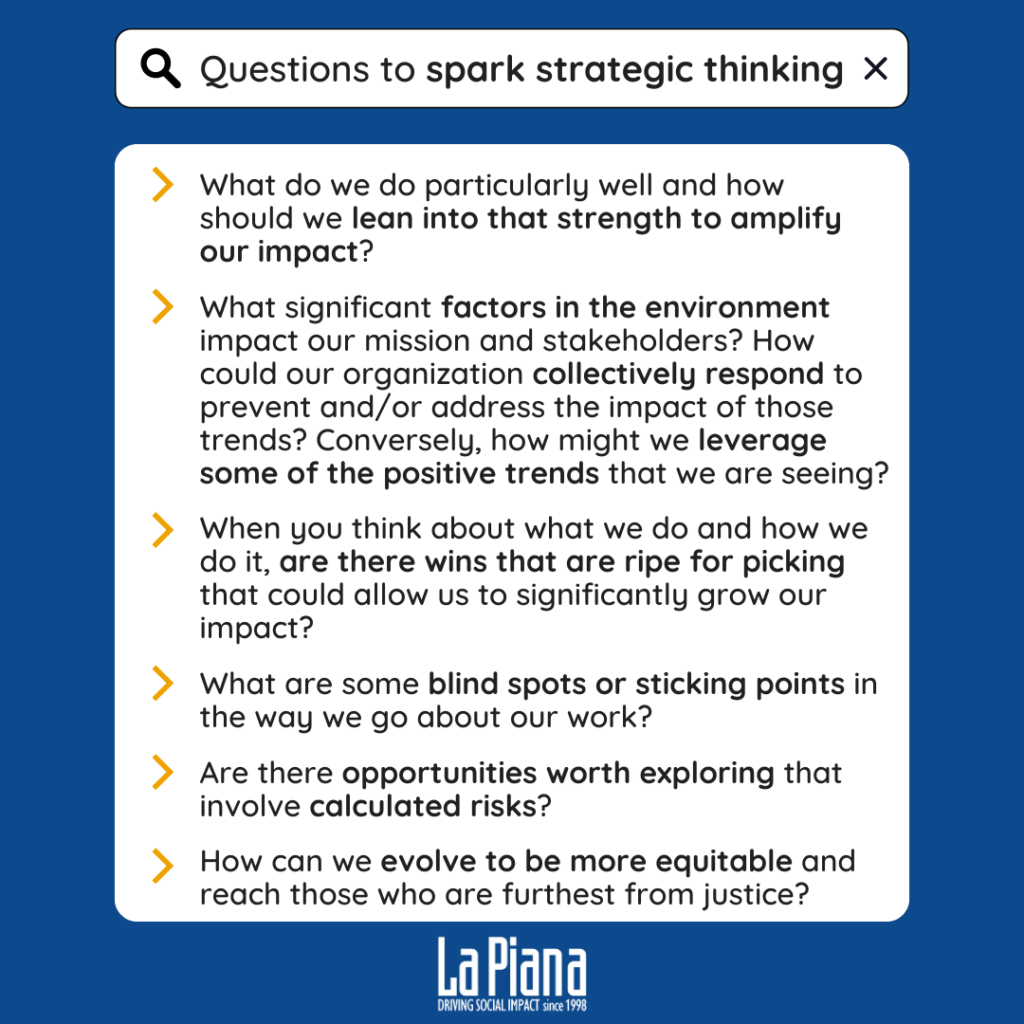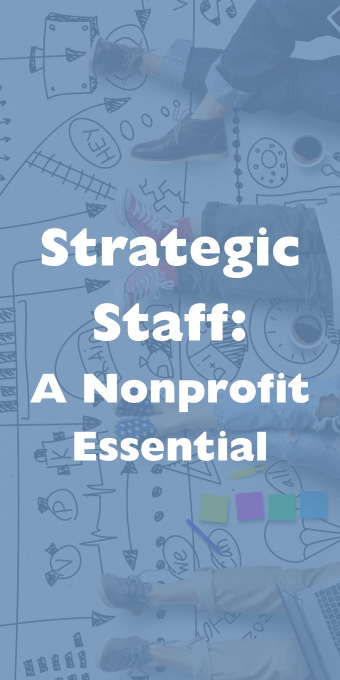Strategic Staff: A Nonprofit Essential
The nonprofit sector operates in a constantly changing environment, with new challenges and opportunities arising regularly due to external factors like policy changes, tech advancements, demographic shifts, and climate change, to name a few.
A common concern that we hear across nonprofits is that organizations tend to be reactive to specific opportunities or circumstances. We also hear that a focus on the operational limits an organization’s ability to look ahead and help steer it through changes in the landscape.
Nonprofit leaders should be intentional about developing strategic thinking among staff, because strategic thought partnership can and should be cultivated. With staff who are proactive and vigilant in identifying these challenges and opportunities, nonprofit leaders can tap into internal expertise to stay ahead of the curve and adapt to its strategies.
So, how can you foster a strategic thinking organization?
Some Considerations
Strategic thinking is a muscle to build. It benefits from time, space, and resources. Below are some things to keep in mind as you nurture and promote a strategic thinking organization.
- Thinking strategically is a skill that benefits from dedicated space and practice. Often, staff already have a lot on their plates, which makes it difficult to take a step back and reflect on how work is done at an organizational level. Practice strategic thinking by incorporating it into staff discussions, like 1-on-1 supervision, team meetings, and all-staff meetings.
- Having a whole picture of the organization is fundamental to thinking strategically. Make sure that staff have the relevant information needed to help them think broadly about the organization, as opposed to thinking solely through the lens of their own department. What information might be helpful for staff to know about your evaluation methods, communication efforts, goals of the board of directors, new initiatives, etc.?
- Regularly share the WHY behind the strategic actions and questions raised. WHY are you going through a strategic planning process? WHY is it relevant to assess the landscape? WHY are you looking to bring staff perspectives into the strategy process? WHY might we want to consider new opportunities or ways of working? This process is fundamental for everyone to understand the purpose of the activities and the root cause and driving forces of our actions.
- Promote cross-pollination. As an organization grows, it’s easy to fall into silos, which limits the perspective a staff member might have on the organization as a whole and it also limits the multiplier effect that comes when departments tap into each other’s knowledge and resources. Hold cross-departmental meetings and promote informal connections across teams to build collaboration and spark innovation.
- Be sure to have multiple channels for staff to share feedback. There are already likely to be many great ideas floating among staff. What systems and processes do they have for sharing them? Be intentional about creating different pathways in which staff can share their feedback and ideas. Think about where bottlenecks might exist that prevent staff from sharing their ideas and how to remove them.
- Make good use of your debriefing muscle. Regularly practice debriefing events, programs, and activities to reinforce learning and growth as part of the organizational culture. Having a space where staff look back at what went well and what could be improved instills a culture of constructive scanning, reflecting, and learning, which will enhance your strategy development process.
- Regularly scan the environment and share learning with staff. For your organization to be proactive and forward thinking field leader, it’s important to know what’s on the horizon. Learn from what peer organizations are doing and about macro trends that are likely to impact your mission. Share these learnings with staff and engage in conversations about what those insights could mean for your organization.
These considerations will help you cultivate a strategic thinking organization by providing discussion spaces and context for strategic thinking to flourish. Below are specific questions and actions you can bring to the table to engage in strategic conversations with staff.

Specific Activities to Develop a Strategic Thinking Organization
If you are looking for hands-on activities to help structure a broader conversation, below are three commonly-used activities, excellent for surfacing possibilities. They are most effective when paired with effective facilitation and thought-provoking reflection questions to provide deeper meaning and alignment.
- Scenario Planning. This activity is used to surface and imagine significant uncertainties that could impact the organization. It is helpful in planning for a variety of potential futures.
- SWOT Analysis. This tool helps identify strategic internal factors (Strengths and Weaknesses) as well as external factors (Opportunities and Threats). Once identified, guiding questions can help identify opportunities to take, risks to mitigate, weaknesses to address, and strengths to leverage. Look especially for an opportunity in an area of strength or a threat in an area of weakness.
- Environmental Mapping. This exercise maps external factors that could impact your mission. Relevant factors include funding sources, policy changes, climate change, demographic shifts, and tech developments.
By fostering a strategic thinking organization, nonprofits lay the groundwork for enduring impact and resilience in the face of uncertainty. With team members across the organization equipped for strategic thinking, you can more confidently continue on a journey of adaptation, alignment, and meaningful change. Where does it makes sense for your organization to start?


Comment section
1 thought on “Strategic Staff: A Nonprofit Essential”